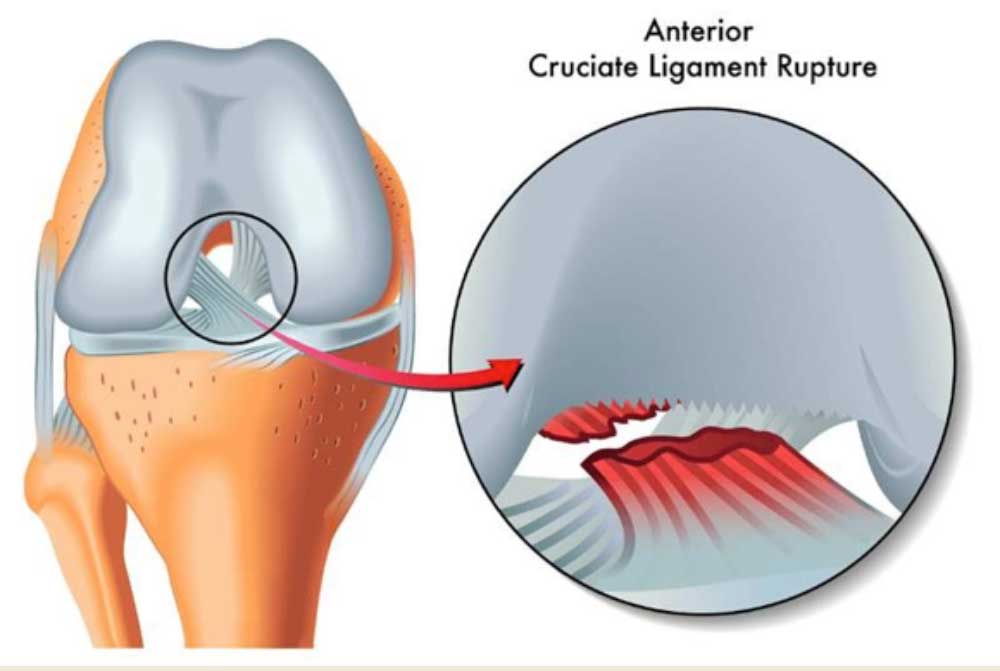ACL Injury Overview
The ACL (anterior cruciate ligament) is an important ligament that helps stabilize the knee in twisting and pivoting sports. Unfortunately it is commonly injured. When the ACL is torn, it usually requires surgical treatment
The ACL is critical to knee stability, strength and mobility, and is generally injured when the knee is sharply twisted or extended beyond its normal range of motion. People who experience an anterior cruciate ligament tear often complain of the following symptoms:
- A popping sound that comes from inside the knee
- Feelings that the knee is giving away
- Immediate, intense knee pain
- Swelling, stiffness and bruising
Trauma to the ACL is typically caused during competitive athletic activity (such as soccer or football) and is also commonly seen during recreational sports (such as water and snow skiing). The ACL can also be injured from falls and other traumatic accidents. Women are at a higher risk for ACL injuries. In fact, competitive female soccer and basketball players have 3-5 times higher risk of ACL injury than their male counterparts. Strength, size and hormonal changes are notable factors that contribute to this increased risk.
ACL Injury Grading System
Many, but not all, ACL injuries will require surgical intervention. It depends on the grade of the ACL injury. Dr. Millett will perform a Lachman test and a Pivot Shift Test to pinpoint how much the tibia (lower leg bone) moves in relation to the femur (upper leg bone). Pain, swelling, and muscle spasms in the early stages of an ACL injury may make it difficult to determine how much instability is occurring. Dr. Millett will also evaluate the knee with an X-ray and MRI.
An ACL knee injury typically is diagnosed in ranges from mild to severe:
- Grade I – A Grade 1 ACL knee injury will include some moderate trauma to the ligament—meaning that some of the fibers are stretched leading to a sprain. There will be some pain and swelling, but this injury can heal on its own through rest, the use of ice and anti-inflammatory medications, and therapeutic knee exercises.
- Grade II – A Grade 2 ACL knee injury will include more extensive damage to the ligament fibers. Symptoms will be more severe. This injury is commonly referred to as an ACL ‘partial tear’ and will sometimes require surgery.
- Grade III – A Grade 3 ACL knee injury is the most severe ACL injury and represents a complete anterior cruciate ligament tear, where the fibers of the knee ligament are completely torn in half. In active patients, this type of ACL injury will almost always require surgical treatment.
Anterior Cruciate Ligament Tear Treatment
Non-Surgical
If a person has injured their ACL, but does not experience knee instability and does not have the need to use their ACL for sports or other daily activities, physical therapy and bracing may be enough to heal the injury. Dr. Millett will consider how old the knee injury is, how old the patient is, and the types of activities the patient enjoys.
The common recommendation for immediate treatment of an ACL injury is the well-known rule of RICE:
R: Rest the knee by using crutches and keeping weight off of it
I: Ice the knee
C: Compress the knee with a wrap
E: Elevate the leg
Surgical
If more than one ligament in the knee has been torn, if the ACL tear is a full tear (grade 3), or if there are signs of ongoing knee instability, pain and swelling, ACL surgery may be recommended. In most cases, if the individual is active and participating in sports with a pivoting nature (such as soccer, tennis, skiing or football) surgery will be recommended to treat the injury so that the athlete can play his or her sport again. In these instances, reconstructive ACL surgery is the best option.
An ACL reconstruction is a surgical procedure—almost always performed arthroscopically with several small incisions. The procedure involves removing the damaged ACL and replacing it with another soft tissue, called a graft. Dr. Millett will usually prefer to use a patient’s own tissue for the graft. The patient’s own tissue heals faster and reduces other known risks. In patients who are older, have had prior knee injuries, or who may not have sufficient tissue for grafting, an allograft (cadaver ligament) might be a better choice. An allograft uses tissue donated by an individual at the time of death.
There are many types of devices used to secure the graft to the bone. The graft is usually secured by screws and or buttons, The type of graft and the anatomic factors will determine the fixation technique.
ACL reconstruction can either be performed in an out-patient setting, or as an in-patient procedure with an overnight hospital stay. Dr. Millett usually prefers for his patients to stay overnight to make sure the patient stays as comfortable as possible.
Physical therapy after the injury and surgery is crucial to help restore strength and motion. Dr. Millett will provide the patient with a detailed set of rehabilitation exercises and a weekly protocol.


